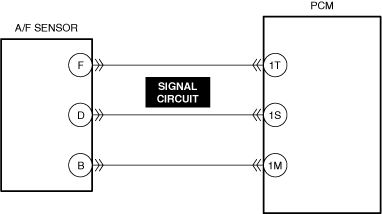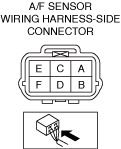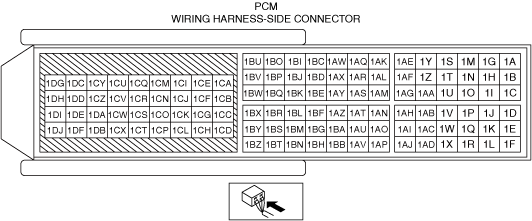DTC P2251:00 [PCM (SKYACTIV-G (US))]
DTC P2251:00 [PCM (SKYACTIV-G (US))]
SM2565569
id0102t48513u0
-
Note
-
• To determine the malfunctioning part, proceed with the diagnostics from “Function Inspection Using M-MDS”.
Details On DTCs
|
Description |
Open circuit between A/F sensor terminal D and PCM terminal 1S |
||
|---|---|---|---|
|
Detection condition
|
Determination conditions
|
• The following conditions are met:
|
|
|
Preconditions
|
• Battery voltage: 11—18 V *1
• A/F sensor is activated.
• The following DTCs are not detected:
*1: Standard can be verified by displaying PIDs using M-MDS
|
||
|
Drive cycle
|
• 2
|
||
|
Self test type
|
• CMDTC self test, KOER self test
|
||
|
Sensor used
|
• A/F sensor
|
||
|
Fail-safe function
|
• Not applicable
|
||
|
Vehicle status when DTCs are output
|
• Not applicable
|
||
|
Possible cause
|
• A/F sensor connector or terminals malfunction
• PCM connector or terminals malfunction
• Open circuit in A/F sensor signal circuit
• A/F sensor malfunction
• PCM malfunction
|
||
 |
|||
 |
|||
 |
|||
Function Explanation (DTC Detection Outline)
Repeatability Verification Procedure
-
Note
-
• Match the engine coolant temperature in the recorded freeze frame data/snapshot data, the vehicle speed, and engine speed values to the best extent possible while driving the vehicle.
PID Item/Simulation Item Used In Diagnosis
PID/DATA monitor item table
|
PIDs |
Reference |
|---|---|
|
A/F_SEN_CUR
|
Function Inspection Using M-MDS
|
Step |
Inspection |
Results |
Action |
|---|---|---|---|
|
1
|
PURPOSE: VERIFY RELATED REPAIR INFORMATION OR SERVICE INFORMATION AVAILABILITY
• Verify related Service Bulletins, on-line repair information, or Service Information availability.
• Is any related Information available?
|
Yes
|
Perform repair or diagnosis according to the available information.
• If the vehicle is not repaired, go to the next step.
|
|
No
|
Go to the next step.
|
||
|
2
|
PURPOSE: RECORD VEHICLE STATUS WHEN DTC WAS DETECTED TO UTILIZE WITH REPEATABILITY VERIFICATION
• Record the freeze frame data/snapshot data and diagnostic monitoring test results (A/F sensor, HO2S related).
|
—
|
Go to the next step.
|
|
3
|
PURPOSE: INSPECT A/F SENSOR CONNECTOR FOR MALFUNCTION
• Inspect the applicable connector and terminal. (See CONNECTOR INSPECTION.)
• Are the connector and terminal normal?
|
Yes
|
Go to the next step.
|
|
No
|
Repair or replace the malfunctioning location.
Go to Troubleshooting Diagnostic Procedure to perform the repair completion verification.
|
||
|
4
|
PURPOSE: INSPECT PCM CONNECTOR FOR MALFUNCTION
• Inspect the applicable connector and terminal. (See CONNECTOR INSPECTION.)
• Are the connector and terminal normal?
|
Yes
|
Go to the next step.
|
|
No
|
Repair or replace the malfunctioning location.
Go to Troubleshooting Diagnostic Procedure to perform the repair completion verification.
|
||
|
5
|
PURPOSE: INSPECT A/F SENSOR SIGNAL CIRCUIT FOR OPEN CIRCUIT
• Inspect the applicable circuit for open circuit. (See CIRCUIT INSPECTION.)
• Is the circuit normal?
|
Yes
|
Go to the next step.
|
|
No
|
Repair or replace the malfunctioning location.
Go to Troubleshooting Diagnostic Procedure to perform the repair completion verification.
|
||
|
6
|
PURPOSE: DETERMINE INTEGRITY OF A/F SENSOR
• Start the engine and warm it up completely.
• Access the A/F_SEN_CUR PID using the M-MDS. (See PID/DATA MONITOR INSPECTION.)
• Drive the vehicle under the following conditions.
• Is the displayed PID value as follows?
|
Yes
|
Go to Troubleshooting Diagnostic Procedure to perform the repair completion verification.
|
|
No
|
Go to the next step.
|
||
|
7
|
PURPOSE: VERIFY CONNECTOR CONNECTIONS
• Access the A/F_SEN_CUR PID using the M-MDS. (See PID/DATA MONITOR INSPECTION.)
• Does the PID value fluctuate when the following connectors are shaken?
|
Yes
|
Repair or replace the applicable wiring harness or connector parts.
Go to Troubleshooting Diagnostic Procedure to perform the repair completion verification.
|
|
No
|
Replace the A/F sensor.
(See AIR FUEL RATIO (A/F) SENSOR REMOVAL/INSTALLATION [SKYACTIV-G (WITH CYLINDER DEACTIVATION (US))].)
(See AIR FUEL RATIO (A/F) SENSOR REMOVAL/INSTALLATION [SKYACTIV-G (WITHOUT CYLINDER DEACTIVATION (US))].)
Go to Troubleshooting Diagnostic Procedure to perform the repair completion verification.
|
Troubleshooting Diagnostic Procedure
-
― Verify that the primary malfunction is resolved and there are no other malfunctions.
|
Step |
Inspection |
Results |
Action |
|---|---|---|---|
|
Repair completion verification 1
|
PURPOSE: VERIFY THAT VEHICLE IS REPAIRED
• Install/connect the part removed/disconnected during the troubleshooting procedure.
• Clear the DTC recorded in the memory. (See CLEARING DTC.)
• Replicate the vehicle conditions at the time the DTC was detected using the following procedure.
• Perform the DTC inspection for the PCM. (See DTC INSPECTION.)
• Is the same Pending DTC present?
|
Yes
|
Refer to the controller area network (CAN) malfunction diagnosis flow to inspect for a CAN communication error.
If the CAN communication is normal, perform the diagnosis from Step 1.
• If the malfunction recurs, replace the PCM, then go to the next step. (See PCM REMOVAL/INSTALLATION [SKYACTIV-G (WITH CYLINDER DEACTIVATION (US))].) (See PCM REMOVAL/INSTALLATION [SKYACTIV-G (WITHOUT CYLINDER DEACTIVATION (US))].)
|
|
No
|
Go to the next step.
|
||
|
Repair completion verification 2
|
PURPOSE: VERIFY IF OTHER DTCs DISPLAYED
• Perform the DTC inspection. (See DTC INSPECTION.)
• Are any other DTCs displayed?
|
Yes
|
Repair the malfunctioning location according to the applicable DTC troubleshooting.
|
|
No
|
DTC troubleshooting completed.
|